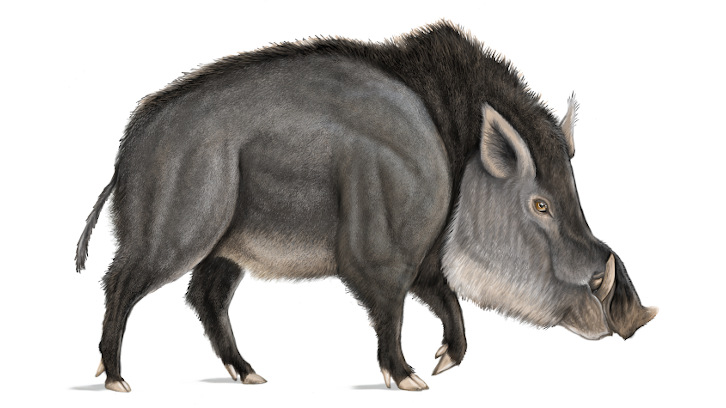The earliest Vallesian suids from Catalonia

In three articles recently published in Journal of Mammalian Evolution, researchers from the Institut Català de Paleontologia Miquel Crusafont (ICP-CERCA) describe the dental remains of suids (pig relatives) from three earliest Vallesian (~11 Ma) sites of the Vallès-Penedès Basin (Catalonia). These fossils attest to the co-occurrence of large-bodied tetraconodontines with the similarly-sized suine Propotamochoerus, coinciding with the dispersal into western Europe of hipparionin horses, which marks the beginning of the Vallesian land mammal age.
Suids (pigs, babirusas, warthogs, and other extinct relatives) constitute a family of non-ruminant artiodactyls (even-toed ungulates) currently represented by a single subfamily: suines. However, back in the Miocenen(23–5 Ma), suids attained a much greater diversity, including up to five different subfamilies, such as tetraconodontines and listriodontines. Despite being frequent in the Miocene of Europe, for many years the suids from the Vallès-Penedès Basin remained largely understudied. This drastically changed during recent years, thanks to work in progress aimed to clarify their taxonomic identity. In fact, three articles that we recently published in the Journal of Mammalian Evolution, where suid remains from three sites of this basin are described: Castell de Barberà (Barberà del Vallès) and Can Missert and Creu de Conill 20 (Terrassa).
These three sites have a similar, earliest Vallesian age (around 11.2 Ma). The Vallesian is a land mammal age originally defined by Miquel Crusafont-Pairó based on the fossil record of the Vallès-Penedès Basin. Until recently, it was assumed that hipparionin equids (tridactyl horses from a different lineage than extant ones) had dispersed at the beginning of the Vallesian. In contrast, research carried out during the last decade shows that the transition between the pre-Vallesian and the Vallesian faunas of Europe involved a more important turnover than traditionally assumed. It not only involved the progressive replacement of multiple genera and species (due to in situ evolution) but also the apparently coeval dispersal of eastern elements—hipparionin equids, giraffids, and sabertooth felids—by the earliest Vallesian.Figure 1: Upper cheek teeth (P2–M3) of Propotamochoerus palaeochoerus from Castell de Barberà (IPS1751–IPS1760). Reproduced from McKenzie et al. (2024).
The composition of the suid assemblages from the three aforementioned sites, which record the co-occurrence of a large-bodied tetraconodontine (Parachleuastochoerus valentini) with a similarly-sized suine (Propotamochoerus palaeochoerus) confirm that the latter species is yet another immigrant from Asia arrived by the earliest Vallesian. For a long time, it was considered that P. palaeochoerus, which is the oldest European suine, arrived well before the Vallesian. However, this has been recently attributed to confusion with Pa. valentini and the incorrect dating of some sites (such as Castell de Barberà). The abundant presence of P. palaeochoerus in the three aforementioned sites (and its absence from older ones) confirms that this species arrived in Europe roughly coinciding with hipparionin equids, thus being a suitable biochronological marker of the Vallesian.
David M. Alba
Institut Català de Paleontologia Miquel Crusafont (ICP-CERCA)
Universitat Autònoma de Barcelona
References
Alba, D. M., Siarabi, S., Arranz, S. G., Galindo, J., McKenzie, S., Vinuesa, V., Robles, J. M., & Casanovas-Vilar, I. (2024). New suid remains from the early Vallesian (Late Miocene) site of Can Missert (Vallès-Penedès Basin). Journal of Mammalian Evolution, 31, 19. https://doi.org/10.1007/s10914-024-09712-9
McKenzie, S., Sorbelli, L., Cherin, M., Almécija, S., Pina, M., Abella, J., Luján, À. H., DeMiguel, D., & Alba, D. M. (2023). Earliest Vallesian suid remains from Creu de Conill 20 (Vallès-Penedès Basin, NE Iberian Peninsula). Journal of Mammalian Evolution, 30, 155-212. https://doi.org/10.1007/s10914-022-09643-3
McKenzie, S., Arranz, S. G., Almécija, S., DeMiguel, D., & Alba, D. M. (2024). Tetraconodontines and suines (Artiodactyla: Suidae) from the earliest Vallesian site of Castell de Barberà (Vallès-Penedès Basin, NE Iberian Peninsula). Journal of Mammalian Evolution, 31, 7. https://doi.org/10.1007/s10914-023-09695-z

